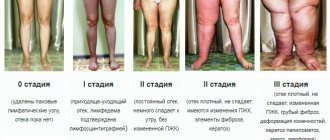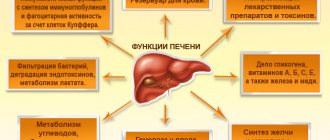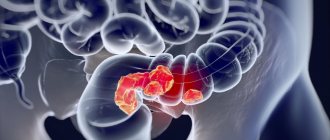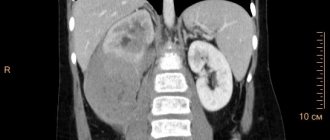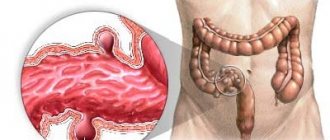Relevance of the problem
The problem of excessive alcohol consumption and its consequences has long attracted attention in almost all countries of the world. According to official statistics, the highest consumption is observed in European countries, where about 50% (58 million people) drink alcohol excessively. Per capita alcohol consumption among persons over 15 years of age is 11 liters of ethanol per year.
Diagnosis and treatment of alcoholic liver disease
To establish a diagnosis, the first step is to confirm a history of chronic alcohol use, including by interviewing relatives. Clinical tests are carried out:
- general blood analysis;
- functional liver texts.
Ultrasound and CT examinations are performed to determine the shape and condition of the liver, if ascites is among the symptoms - fluid analysis. In some cases, a liver biopsy may be recommended.
Treatment is carried out on an outpatient basis if the condition does not threaten the patient’s life: with steatosis, compensated cirrhosis, low-active hepatitis. In the presence of ascites syndrome, decompensated cirrhosis and high activity hepatitis, hospitalization and inpatient treatment are indicated. Here the patient goes through a liver cleansing procedure and is prescribed general tonics.
Reasons for development
The main reason for the development of ALD is alcohol abuse. Doses exceeding 30 ml of vodka (cognac, whiskey), 150 ml of wine or 250 ml of beer per day for women and 60 ml of vodka (cognac, whiskey), 300 ml of wine or 500 ml of beer per day for men are considered dangerous. The fact of abuse is easy to determine using a special questionnaire (CAGE). This is evidenced by at least two positive answers to the following questions:
- Have you ever thought that you should reduce your alcohol consumption?
- Does it happen that people who criticize your alcohol consumption irritate you?
- Do you feel bad or guilty after drinking alcohol?
- Do you sometimes drink alcohol in the morning to improve your mood or get rid of a hangover?
Additional risk factors for liver damage are:
- drinking beer or strong alcohol;
- malnutrition;
- drinking alcoholic beverages on an empty stomach;
- female;
- deficiency of vitamins A and E, protein;
- excess polyunsaturated fats in the diet;
- obesity and overweight;
- hepatitis C;
- hereditary predisposition.
Etiology
The most obvious reason for the development is long-term abuse of alcoholic beverages. In this case, not only the amount of alcohol matters, but also the frequency of drinking episodes and the specific type of strong drinks. For most people, the critical dose of ethanol is 80–160 g per day over 10–20 years of regular drinking.
But in women, the disease develops when drinking much smaller doses of alcohol (20–40 g per day) and over a shorter period. This is explained by the smaller number of enzymes involved in the breakdown of ethanol. And if therapy is started too late, in 50% of women the pathology progresses to hepatocellular carcinoma, even if they get rid of addiction.
According to experts, one-time alcoholic excesses (even with significant alcohol abuse) are safer, since a rare intake of alcohol gives the liver the opportunity to “recover”, which cannot be said about daily drunkenness.
In addition, the risk of alcoholic liver toxicosis is increased if:
- genetic characteristics due to which the mechanisms for the production of enzymes that affect the metabolism of alcohol are disrupted;
- being overweight, which provokes the accumulation of visceral fat;
- concomitant viral and infectious liver diseases;
- taking hepatotropic medications (antifungals, antibiotics, immunosuppressants), antiulcer medications that reduce the activity of alcohol dehydrogenase;
- autoimmune diseases.
Mechanisms of liver damage
A key role in alcohol damage to the liver is played by ethanol and its more toxic derivative, acetaldehyde. Several mechanisms of damage can be distinguished.
- Firstly, alcohol promotes increased formation of fatty acids and reduces their oxidation. This leads to the accumulation of excess fat in liver cells (hepatocytes), that is, to the development of fatty degeneration.
- The second mechanism of liver damage is associated with the oxidation of alcohol by enzymes, in particular alcohol dehydrogenase. As a result, free oxygen radicals (oxidative stress) and acetaldehyde are formed in excess, which have a damaging effect on its cells.
- The third mechanism is due to increased permeability of the intestinal wall. As a result, lipopolysaccharides (waste products of gram-negative intestinal flora) penetrate through the blood into the liver, where they stimulate the production of proinflammatory cytokines by Kupffer cells - biologically active substances that cause inflammation.
- The fourth mechanism is associated with free radical activation of the immune system and immune-mediated inflammation and liver damage.
The consequence of inflammation is the destruction of hepatocytes (cytolysis), their death (necrosis) and the proliferation of connective tissue (fibrosis). Progressive fibrosis leads to disruption of the normal lobular structure of the liver - cirrhosis, and subsequently to primary cancer - hepatocellular carcinoma.
How does the liver react to alcohol?
Under the influence of alcohol, processes are launched in hepatocytes (liver cells) that lead to the destruction of cell membranes, substances are produced that destroy liver cells and block the mechanisms of regeneration (restoration) of the liver.
Long-term exposure of the liver to toxic doses of alcohol leads to the formation of dense fatty tissue instead of destroyed liver cells. It does not perform the numerous functions that are characteristic of liver cells, which provide basic vital processes in the body. The terminal stage of the disease is characterized by the development of hepatic cellular failure.
In addition, dense adipose tissue interferes with normal internal circulation with a subsequent increase in pressure in the portal vein (portal hypertension) and an enlarged spleen. A real threat to life is internal bleeding from the dilated veins of the stomach and esophagus.
With the same alcohol consumption in different people, the severity of liver damage depends on their individual sensitivity to the toxic effects of alcohol. In this case, gender, age, genetic characteristics, type of drinks consumed, the presence of hepatitis viruses, iron overload and other factors matter.
The amount of alcohol consumed per day and its quality are also important prognostic indicators of its effect on the liver.
Symptoms of the disease
ALD can be asymptomatic. However, symptoms of alcoholic liver damage may be nonspecific. These include complaints such as heaviness or pain in the right hypochondrium, bloating, abnormal stool, nausea, etc.
In addition to the liver, other organs and systems may be involved in the pathological process. In particular, there may be atrophy of the muscles of the shoulder girdle, impaired sensitivity in the extremities (polyneuropathy), heart disease (cardiomyopathy), and pancreas disease (pancreatitis).
Content:
- Etiology.
- Pathogenetic mechanisms of liver intoxication.
- Clinical picture of alcoholic liver intoxication: 3.1. Steatosis. 3.2. Alcoholic hepatitis. 3.3. Cirrhosis.
- Diagnostics.
- Principles of treatment: 5.1. Nutrition correction. 5.2. Drug treatment.
Alcoholic liver intoxication refers to the sequential development or combination of several diseases: steatosis (fatty degeneration), hepatitis and cirrhosis. In this case, the pathology can be asymptomatic (or with a “blurred”, non-specific clinical picture) until the development of irreversible changes. According to WHO, alcoholic liver poisoning is the most common disease in hepatology.
Diagnosis of the disease
Laboratory methods
Laboratory symptoms are primarily
- increased levels of liver enzymes: ALT (alanine aminotransferase) and AST (aspartate aminotransferase) in the blood, with an AST:ALT ratio > 1.5.
- increased blood levels of gamma-glutamyl transpeptidase (GGT), a carbohydrate-deficient transferrin
- reduction in the size of blood cells - red blood cells (erythrocyte microcytosis).
Ultrasonography
Ultrasound examination (US) can detect an increase in the size of the liver (hepatomegaly), its heterogeneity and increased echogenicity. In addition to ultrasound, computed tomography (CT) and magnetic resonance imaging (MRI) are used as imaging methods.
Biopsy
The diagnosis and stage of the lesion can be accurately determined by biopsy. A non-invasive alternative to biopsy is elastography. It is a timely diagnostic method that allows you to assess the elasticity of organ tissue using an ultrasound sensor.
Until jaundice and stars. Is it possible to understand on your own that it’s time to quit drinking?
Many believe that chronic fatigue and pain in the lower abdomen are the first symptoms of alcoholic liver disease. Is it possible to judge the onset of the disease from them? Why is sweet alcohol the most toxic? Professor of Sechenov University, gastroenterologist Alexey Bueverov told AiF about this
Yulia Borta, AiF : Alexey Olegovich, how can one suspect alcoholic liver disease if a person regularly drinks alcohol ?
Alexey Bueverov: In the early stages - no way. A person drinks, he feels good, nothing hurts, nothing bothers him. As Academician Vasilenko, one of the founders of Russian gastroenterology, put it, the patient does not suffer from alcoholism, he enjoys it. Those around you most likely suffer. When clinical signs of alcoholic liver disease appear, then, as a rule, it is already cirrhosis or severe alcoholic hepatitis, which can be layered on top of the same cirrhosis. Most often this is what happens. Signs: jaundice, loss of appetite, change in sleep rhythm (a person sleeps during the day and is awake at night). However, these are far from the initial stages.
Alcohol is a total poison that affects all organs and systems, not just the liver. Therefore, pancreatitis, an inflammation of the pancreas, can develop before cirrhosis. And it can just manifest itself as pain in the abdomen. A fairly typical picture is pain in the middle parts of the abdomen, in the peri-umbilical region, spreading to the lateral areas, sometimes encircling the abdomen. This is something the patient can pay attention to.
— Does pain occur after a person drinks?
— No, there are even situations when alcohol reduces pain and acts as an anesthetic. And this can serve as a trigger for the examination. Basically, such patients come when they not only have cirrhosis, but when cirrhosis has already led to a serious impairment of liver function. This means that jaundice has appeared (including yellowing of the whites of the eyes), and constant fatigue. Plus, a person develops vascular growths on the skin - crimson spider stars. This stage requires active drug intervention.
And the early stages of almost any chronic liver disease show almost no symptoms. The liver is an organ that endures for a long time, and then “falls off.” Moreover, if the patient drinks regularly, then he is in a state of euphoria: he feels good, he does not go to the doctors. And if those around him and his relatives don’t urge him on, then he won’t go anywhere.
— Is it possible to cure if a person comes with signs of cirrhosis?
— You can help even in the later stages of cirrhosis. The main thing is that the patient stops drinking. Or at least sharply reduced the amount of alcohol consumed. Because such patients most often cannot stop drinking. There are medications that help overcome alcohol addiction. They act on opioid receptors. They first treated opioid addiction, and then extended it to alcoholism, since the mechanism of addiction formation is similar. Of course, such drugs must be prescribed by a specialist; they are not intended for self-administration. All prescription medications have side effects.
— That is, if a person nevertheless feels that the liver is no longer working well, gets scared and stops drinking, will he be cured?
— It’s difficult to scare an alcoholic with anything. These people are brave. They live in their own world, in a state of constant euphoria. The motivation for the examination may be the actions of caring people, relatives or colleagues. Let's say a person occupies a responsible position and breaks contracts and meetings one after another. Colleagues bring him to an appointment, and he says: “Doctor, what are you talking about? I'm fine".
If relatives notice external signs of liver disease or signs of addiction, you need to convince the person to go to the doctor. These are situations when alcohol crowds out other interests, a person cannot stop, and gets drunk to the point of, as people say, “out of the woods.” He disrupts planned events. For example, we agreed to go to a concert, but by the time of the concert the person is no longer able to go.
— What dose can lead to such problems?
— There is a concept of “hepatotoxic dose of alcohol.” This is approximately 30 g of pure alcohol per day for men and 20 g for women for a long time. As a rule, at least 5 years. It happens even faster. But these are very average doses. They only indicate an increased risk of developing alcoholic liver damage, but do not at all guarantee that a person will definitely have cirrhosis or severe alcoholic hepatitis. Basically, of course, such patients drink a lot: 120 g or more in terms of pure ethanol per day. Or approximately 0.3 liters of vodka or strong drinks daily for a long time. But most often it is even higher doses almost every day.
— Could there be risk groups whose liver will be damaged more quickly by alcohol?
— Risk groups are patients with obesity or, on the contrary, with extremely low body weight. Being too fat is bad, being too thin is bad. These are also patients with a genetic predisposition to alcoholic liver disease. It is not always easy to identify. If one of your blood relatives once had alcoholic organopathies, alcoholic liver disease, this increases the risk. Finally, these are patients with chronic underlying liver disease, such as chronic viral hepatitis, certain hereditary liver diseases, and metabolic fatty liver disease.
— Which alcoholic drinks are most harmful to the liver?
— Sweet alcohol, sweet alcoholic cocktails. Fructose increases the toxicity of alcohol. Plus, it is converted into fat faster, which is also harmful. And fructose can also induce inflammation. By the way, it’s better to drink alcohol not with fruit juice (it contains a huge amount of sugar), but with tomato or mineral water.
Photo: Shutterstock.com
Link to publication: aif.ru
Treatment methods for ALD
Drug and non-drug approaches to therapy can be distinguished.
Medication
Non-drug treatment requires complete abstinence from alcohol .
Medication
A drug for the treatment of alcoholic liver disease should have an antioxidant effect, suppress inflammation and prevent the progression of fibrosis. Such a drug is Phosphogliv*
, which has demonstrated all these effects in clinical studies. It should be taken 2 capsules 3 times a day with meals, without chewing, with a small amount of liquid. The course duration is usually 3 months.
If you suspect the development of liver disease, you should consult a doctor.
Pathogenesis
The disease can develop over a long period of time: months and years. The pathological influence of viruses on liver cells, toxic substances (drugs, alcohol), impaired blood supply to the organ, immune mechanisms, and the influence of inflammatory mediators lead to massive death of hepatocytes and replacement with connective tissue. This process disrupts all vital functions of the liver.
- 1. Fatty degeneration. Initial changes in the structure and function of hepatocytes, which can completely disappear within a few weeks if the intake of alcohol in the body is stopped.
- 2. Steatohepatitis. An inflammatory process develops. The structure and size of hepatocytes change; in severe cases, the cells die, which affects the general condition of the liver. At this stage, disturbances in the functioning of the organ already occur, and specialized treatment is also required.
- 3. Cirrhosis. The formation of irreversible fibrous changes in the organ, disruption of the general structure: the appearance of tuberosity, reduction in size. If left untreated, the condition progresses and liver functionality decreases. Dangerous complications develop not only in the organ itself, but also in the structures dependent on it.
The sooner you consult a doctor and, most importantly, stop drinking alcohol, the higher your chances of getting rid of the problem.
Mechanism of treatment of the syndrome
The goal of treatment is to stop the further development of liver disease and stop necrosis of organ cells. The most important thing is that the patient completely stops drinking alcohol. Diet is also a significant factor in recovery. The patient needs to be provided with good nutrition with vitamin supplements and plenty of fluids.
Diuretics and antihypertensive drugs are also used in therapy. They lower liver blood pressure. If liver function is so poor that waste products such as ammonia are not eliminated naturally, they affect the brain and liver failure (hepatic encephalopathy) develops. Since ammonia is produced in the colon, its elimination can be increased with the help of laxatives. Cirrhosis is treated with antibiotics and protein-rich diets.
In cases of severe jaundice and alcoholic inflammation, they are treated with the adrenal cortical hormone - prednisole.
Methods for restoring the liver after heavy drinking
When treating the liver, complex therapy is used, which includes mandatory detoxification, diet, and taking medications and supporting herbal preparations. The doctor makes individual prescriptions depending on the type of disease diagnosed and its stage.
Liver cleanse
Detoxification accelerates the removal of harmful substances from the body and acts as a catalyst for the natural restoration of the liver. Sorbents are used for cleaning. They bind toxins and ensure their rapid elimination. For minor damage, medications are taken orally.
The most effective and safe way of detoxification for any pathology is infusion therapy. The administration of drugs through a cleansing dropper ensures their direct entry into the bloodstream, preventing additional stress on the liver and gastrointestinal tract. Intravenous infusion has an effect within 30-60 minutes. For minor intoxication, 1-3 procedures are sufficient. To completely cleanse the liver after prolonged use of alcohol, it is recommended to complete the full course for 5-10 days.
Maintaining a daily routine and diet
Diet therapy plays an important role in recovery. Food should be rich in vitamins and proteins, easily digestible, so as not to put additional stress on the liver. The following should be excluded from the patient’s diet:
- smoked meats;
- fatty and salty foods;
- caffeinated drinks;
- semi-finished products;
- canned food and marinade;
- rich broth, fish soup;
- mushrooms, legumes;
- sweet pastries, ice cream.
Meals are recommended in fractional, small portions. Food should be light, contain antioxidants and vitamins. Food needs to be boiled, steamed, stewed, baked. You should add to your diet:
- boiled lean meat: turkey, rabbit, beef, chicken fillet;
- sea fish containing fatty acids;
- porridges rich in carbohydrates (buckwheat, oatmeal, wheat);
- vegetables and fruits, freshly squeezed juices;
- durum wheat pasta;
- fermented milk products.
It is not recommended to eat before bed. If you feel hungry, you can get by with an apple or dairy products. It is necessary to drink at least 2 liters of fluid per day to prevent dehydration. Fruit drinks and weakly brewed black or green tea are recommended. You can drink still mineral water, preferably before meals.
In addition to following a diet, it is necessary to ensure moderate physical activity to improve blood circulation and speed up the elimination of toxins. A sedentary lifestyle leads to obesity, and weight gain increases the load on the liver. Long walks in the fresh air, swimming, and yoga are recommended. If there are no disorders of the respiratory and cardiovascular systems, you can visit the bathhouse or sauna.
Healing herbs
To restore liver cells, take infusions of the following medicinal plants:
- knotweed Has a mild diuretic effect, accelerates the elimination of toxins, has anti-inflammatory and antimicrobial effects;
- mint. It has a calming effect, relieves irritability and eliminates emotional instability, which are one of the symptoms of liver pathology. Mint is rich in vitamins, improves appetite, stimulates bile secretion;
- sagebrush. Contains B vitamins and vitamin C. It has an antispasmodic effect, stimulates the production of gastric juice, and improves bile secretion. It is used for both treatment and prevention of liver diseases;
- calendula. Normalizes metabolism and has a choleretic effect. A decoction of calendula is especially effective in restoring the liver in combination with an infusion of chamomile and yarrow;
- decoction of chamomile flowers. The plant has anti-inflammatory properties, destroys bacteria, and has a choleretic effect. Chamomile has a powerful antioxidant and antispasmodic effect;
Medicinal herbs can be taken individually or as part of a collection to enhance the therapeutic effect. The main disadvantage of herbal medicine is that its effect occurs after 2-3 weeks.
Consult your doctor before your appointment!
Herbal infusions are an auxiliary method in treatment and help only with minor damage to liver cells. They should be taken with caution. Herbs have many contraindications, can lead to exacerbation of concomitant diseases, and cause a severe allergic reaction.
Drug treatment
When treating liver pathologies, pharmacotherapy is mandatory. The selection of drugs for the restoration of organ cells after heavy drinking is carried out by a narcologist, hepatologist, and gastroenterologist. Several types of medications are used.
Hepatoprotectors
Hepatoprotectors are a group of medications and dietary supplements that reduce the toxic effects of alcohol and promote the restoration of liver cells. Depending on the active substance, there are several types of drugs:
1.
Plant-based hepatoprotectors. Milk thistle preparations, which contain silymarin, are used. The substance has a powerful antitoxic effect, has an anti-inflammatory effect, protects liver cells and stimulates the regeneration process by restoring protein synthesis. Milk thistle causes an aversion to alcohol and is therefore used in the auxiliary treatment of alcohol dependence.
Another effective herbal component for liver restoration is artichoke. The plant extract has a choleretic effect, neutralizes toxins, helps normalize lipid metabolism and weight loss, and reduces the load on the liver.
2.
Medicines based on amino acids. The most effective is the complex drug Heptral. In addition to essential phospholipids, it contains ademetionine. This is an amino acid that regulates biochemical processes, restores choleretic function and ensures natural regeneration of liver cells. Ademetionine eliminates the manifestations of depression and reduces anxiety, due to which it is used in the treatment of alcoholic depression and psychosis. The effect of Heptral begins within 5-7 days after administration. The drug has a prolonged effect of up to 3 months.
3.
Essential phospholipids. They restore metabolism, neutralize the effects of toxins, and prevent fibrosis. Phospholipids promote the regeneration of hepatocytes and relieve unpleasant symptoms of liver diseases. Thanks to their natural composition, the medications have no contraindications and can be taken for a long time. Essentiale forte N and Phosphogliv are recognized as the most effective.
4.
Preparations based on ursodeoxycholic acid (UDCA). They have a choleretic, antioxidant, immunomodulatory effect, protect liver cells from destruction by toxins. In hepatology, Livodex, Ursosan, Ursoliv are most often used. UDCA preparations have the greatest effect in combination with essential phospholipids.
It is impossible to completely restore the liver with the help of hepatoprotectors alone if you continue to drink alcohol. Abstinence from alcohol is required, as well as long-term complex treatment.
Glucocorticosteroids
Glucocorticosteroids (GCS) are hormones that have an anti-inflammatory effect, stimulate metabolism, and reduce swelling. GCS are concentrated in the area of inflammation and prevent scarring of liver tissue. To eliminate symptoms of organ damage, Hydrocortisone and Prednisolone are prescribed. Taking hormones should only be done under the supervision of a doctor. The drugs have many contraindications.
Restoring the liver through detoxification, pharmacotherapy, diet and traditional methods will only help with minor cell damage during steatosis or the initial stage of hepatitis. If the disease has reached the final stage with irreversible damage, only an organ transplant will help.
Liver transplantation
Transplantation is a surgical intervention to replace the damaged part of an organ. It is performed for cirrhosis or cancer, when cell destruction is irreversible and leads to death. The liver is the second most frequently transplanted organ. The chances of an alcoholic getting it are slim. A candidate for a donor organ will only be considered if he or she has completely abstained from alcohol for 6 months or more. Before transplantation, it is necessary to undergo complete cleansing of the body and treatment for addiction to eliminate the risk of relapse.
Transplantation is successful in 85% of cases and prolongs the life of an alcoholic by several years. After the transplant, drinking alcohol in any quantity is permanently prohibited. The slightest dose of ethanol will cause instant liver failure and death.
Complete or partial restoration of the liver is possible only with complete abstinence from alcohol, timely consultation with a doctor, and receipt of the necessary treatment. After undergoing therapy, you must constantly adhere to your daily routine, diet, and give up alcohol forever. With strict adherence to the recommendations, even with significant liver damage, it is possible to achieve stable remission of the disease and prolong life.
Establishing diagnosis
The doctor determines the duration of alcohol use or the degree of alcoholism. Based on these data, the patient is prescribed a medical examination. Both general diagnostics and blood tests can determine the extent of liver damage. For this purpose the following is carried out:
- Lab tests.
- Histological studies.
- Ultrasound. To have a visual idea of the disease picture, an ultrasound examination of the liver is performed.
- Biopsy. To do this, the doctor removes a tissue sample using a needle.
- Magnetic resonance and computed tomography.
